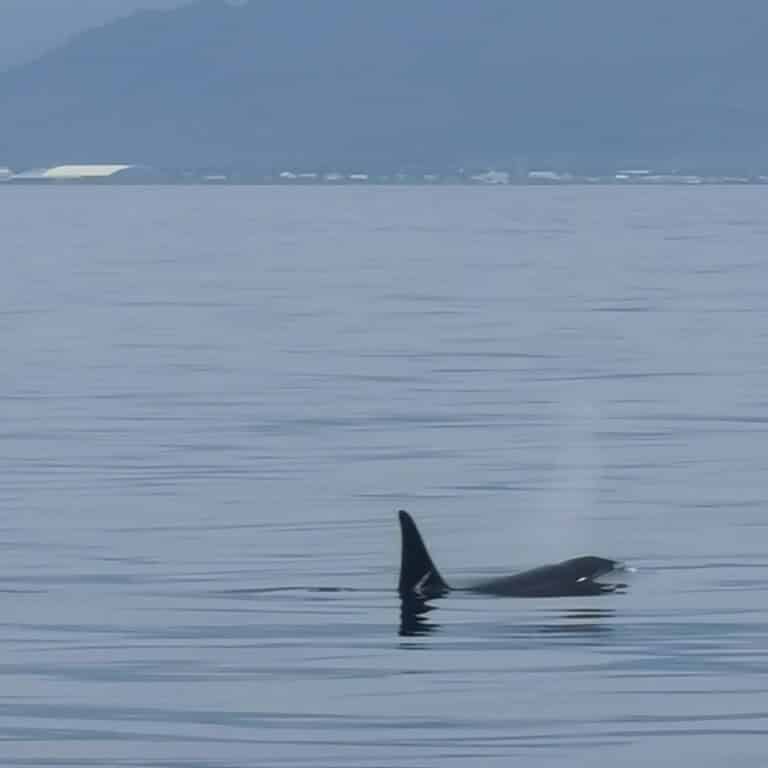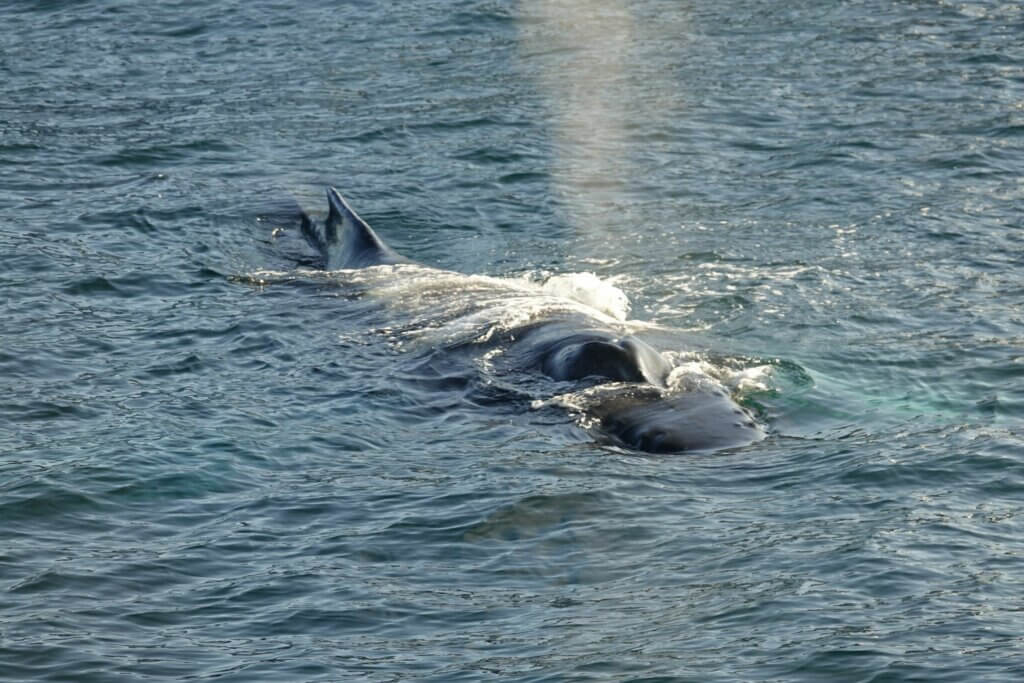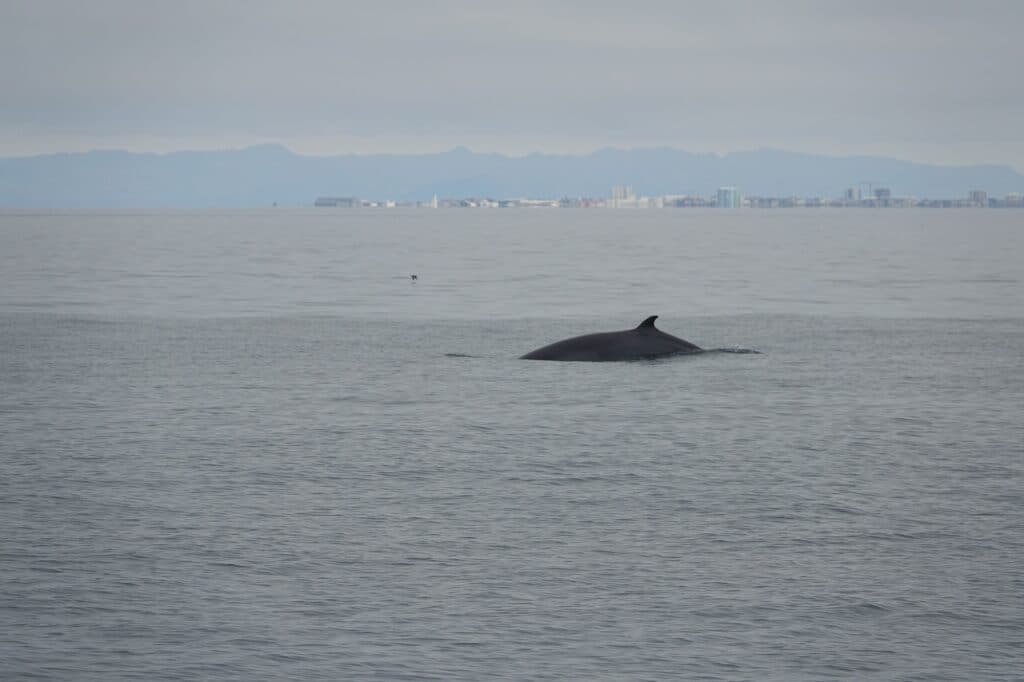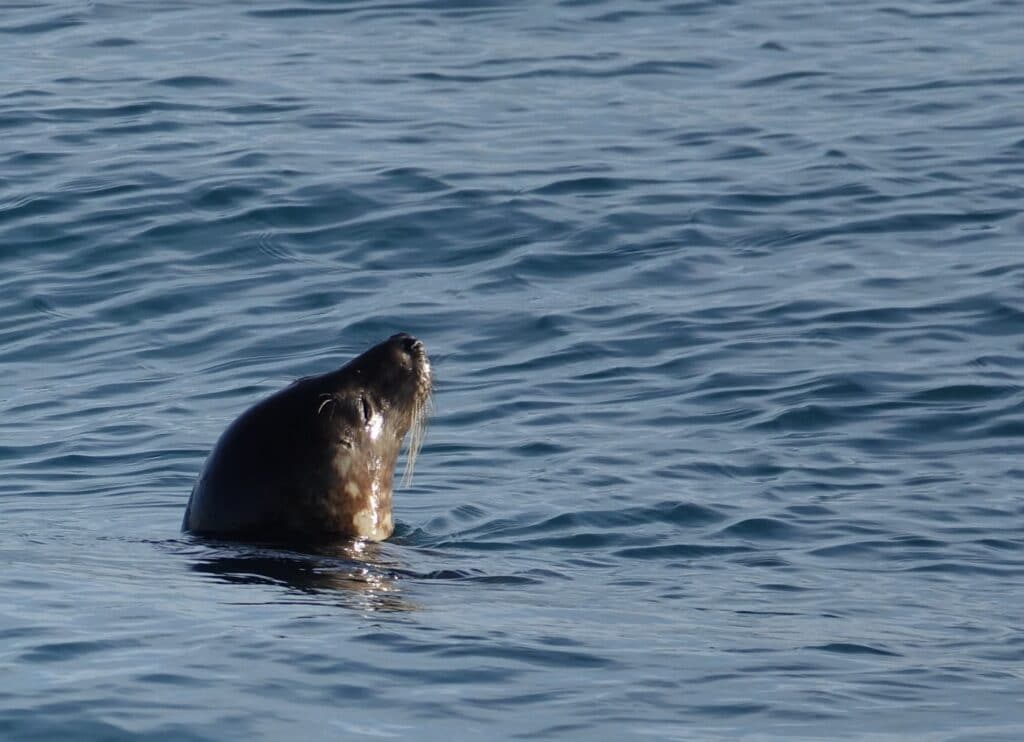Orca, humpbacks, dolphins and puffins…all with a live volcano as a backdrop. Welcome to Iceland. 08 June 2021.

Everyday out on the water is different, but seeing orca next to a humpback? Incredible.
By Lucky Byfleet
To protect our oceans we teamed up with Harpa Yachts today, another gorgeous yacht. The water was flat calm as we left Reykjavik harbor, with low clouds giving otherworldly lighting, and a layer of fog close to the ocean surface giving an ethereal, ominous feeling. Natures smoke machine!
The weather dried up after several rainy days and we found many birds near the islands we sailed by, including lots and lots of puffins! As we sailed through the harbour islands of Videy, Engey, Akurey and Lundey we taught our lovely customers how to spot whales, and what they can hope to see… orca (killer whales) were not on the list of usual suspects! If you want to learn how to spot whales then have a look at this article.
The quantity of birdlife feeding gave us great hope as it meant there was a lot of fish in the area, and lots of fish means lots of things feeding on the fish! But each patch of birds we came close to had nothing else in the area. It was disappointing but we persevered. We knew there had to be something awesome around when there was that much fish, and the water was so calm it was like a mirror, meaning we should be able to spot cetaceans relatively easily!
Suddenly a blow was spotted – a whale for sure but what kind? Then it splashed its pectoral fin on the water surface – it was definitely a humpback whale. Their pectoral fins are a third of their body length and they love to slap them on the water surface to communicate (we think – there are other theories like scaring fish.)

The humpback swam over to us, just lazily surfacing and breathing then resting just underwater again, it came right up to the side of the yacht, but whilst we were admiring it we saw in the distance the unmistakable fin of an orca! We didn’t know whether to head to the killer whale (orca) straight away or enjoy the humpback next to us. Although we wanted to go and see the orca we didn’t want to startle the humpback next to us. Thankfully it also decided our time with it was up and did a huge beautiful dive next to us, showing us the incredible markings on its tail before swimming away. We continued on towards the orca.
As we came closer to the orca (but not too close – we always let whales approach us) we could see there was actually two killer whales swimming together, one male orca, one female. The difference is easy to spot – a fully grown make orca has a huge dorsal fin – straight up – about as tall as an adult human! When orca have a fin flopping to the side it means they are unhealthy – and this is found in captive orca. The female has a smaller fin, and slightly more curved – the same as a young male.
Orca Guardians identified the make orca as one that swims between Iceland and Scotland – such a huge range! It is wonderful to be able to know a small part of this incredible whale’s story!
Thanks to the clean water and high levels of fish in our ocean the whales that visit us come very close to Reykjavik harbour. Sometimes they come right the way into the inner harbour, as they are extremely intelligent and curious. The whales we most commonly see are minke whales and humpback whales – it is really really rare that we see an orca!
It was a wonderful day for everyone and a real joy to see. We were delighted to show such an amazing animal to everyone and hope they developed a lifelong love for these majestic animals because of it. Their welfare is ever so important to us, and if everyone acted in small ways, like only buying ethically-sourced fish, we can protect them for years to come.
For more information on how we search for whales and dolphins, and learn how to be a pro-cetacean spotter yourself have a look at our guide here.
Many people come to see the wonderful wildlife here, but they also come to see the bewitching northern lights, and we take people out again on our lovely super yacht Amelia Rose. When you book a whale watching tour with us you get 50% off your northern lights tour!
Sea Trips Reykjavik sail everyday from Reykjavík Old Harbour, Iceland. Our yacht Amelia Rose was built as a super yacht in 2003 and as such is extremely comfortable and stable, with three viewing decks, a bar, and plenty of comfortable seating. However the seas often change here, and people are affected differently by the movement of the oceans. As such we have seasickness tablets available for free at the bar. We also have warm blankets and ponchos around the yacht for your comfort, though the inside of the ship is extremely warm and snug.
For more information on our boats, our trips and any accessibility questions please email us at seatrips@seatrips.is

What is the difference between baleen and toothed whales?
We see both toothed and baleen whales here in Reykjavik harbour, Iceland. Did you know that dolphins and porpoises are also part of the same family? www.uk.whales.org is a brilliant website that goes into a lot more detail however this is the basic description!
They write that;
“Baleen whales have baleen plates, or sheets, which sieve prey from seawater. Toothed whales have teeth and they actively hunt fish, squid and other sea creatures. Dolphins and porpoises all have teeth and rather confusingly are known as ‘toothed whales’ too!
Another obvious difference between baleen and toothed whales is the number of blowholes on top of their head; baleen whales have two whereas toothed whales have one. There are only 14 baleen whale species and they are generally larger than the 76 species of toothed whales – except for the mighty sperm whale, the largest toothed whale.”
If you are interested in learning more we recommend these websites, https://www.nationalgeographic.com/animals/mammals/group/whale-facts/ and https://www.worldwildlife.org/species/whale They have a lot of extra learning materials about cetaceans all over the world.


